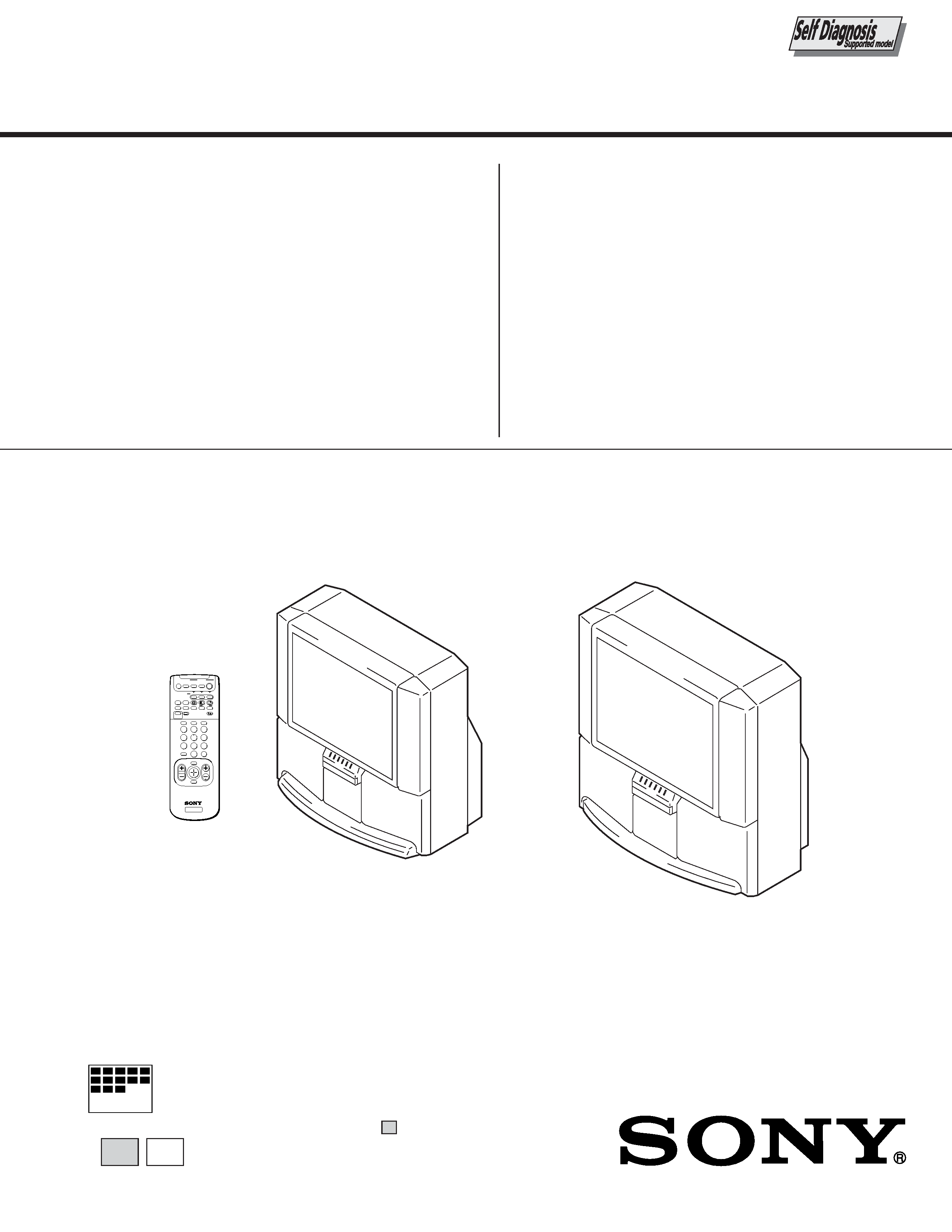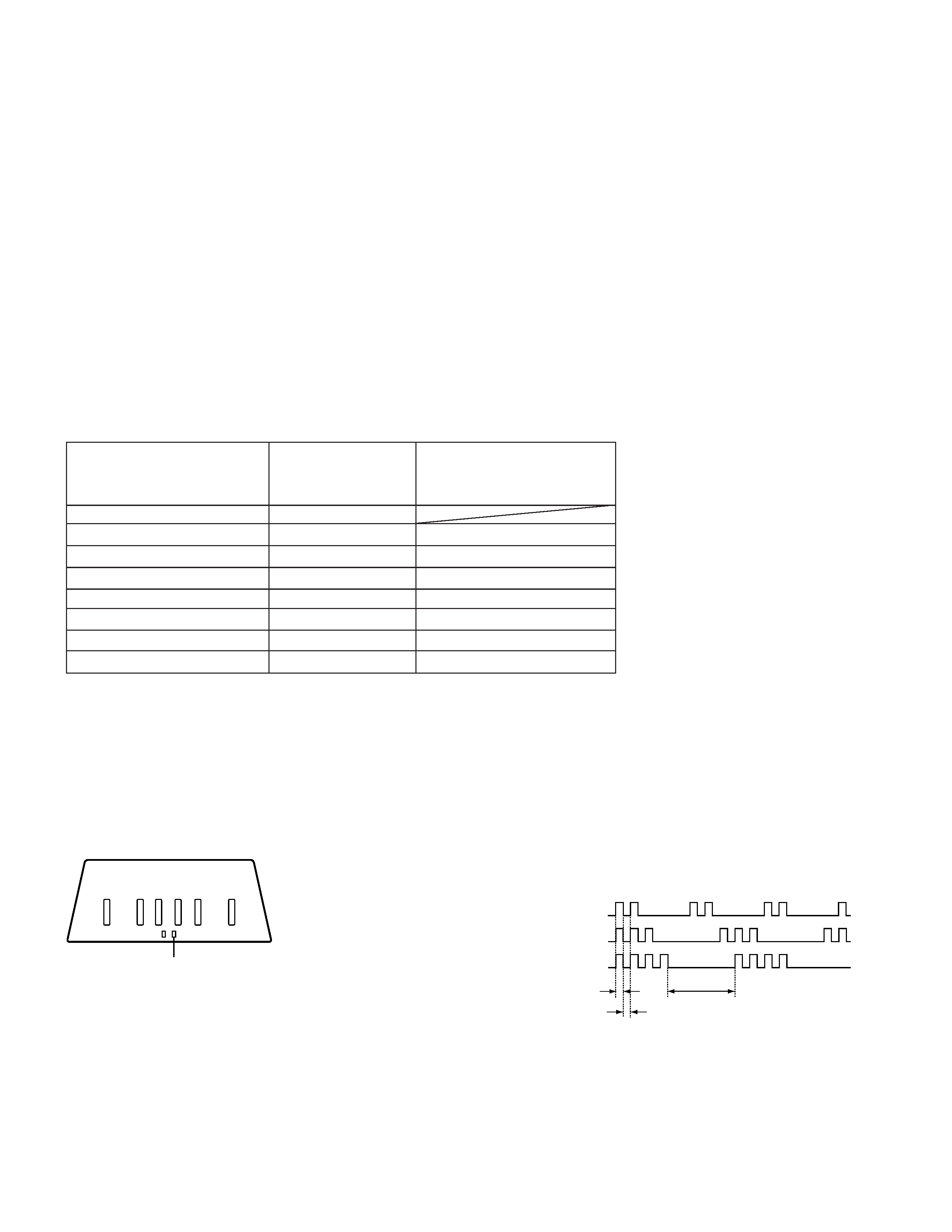
CHASSIS
RA-4
SERVICE MANUAL
MODEL
COMMANDER
DEST. CHASSIS NO.
KP-53XBR200 RM-Y902
US
SCC-N90A-A
KP-53XBR200 RM-Y902 Canadian SCC-N90A-A
KP-61XBR200 RM-Y902
US
SCC-N90B-A
KP-61XBR200 RM-Y902 Canadian SCC-N90B-A
MODEL
COMMANDER
DEST. CHASSIS NO.
MICROFILM
53
61
Please file according to model size. .......
TV
2
5
8
0
1
4
7
3
6
9
DISPLAY
TV/VIDEO
ANT
JUMP
ENTER
MENU
RESET
VOL
CH
MUTING
TV
OFF
AUDIO
SWAP
TV/DBS
PICTURE
MODE
GUIDE
ACTIVE
POTITION
LEFT
RIGHT
ZOOM IN
FREEZE
POWER
SYSTEM
OFF
DVD/
VTR
DBS
CABLE
FUNCTION
DVD/VTR DBS/CABLE
TV
CC
KP-61XBR200
KP-53XBR200
RM-Y902
Color Rear Video Projector

2
SPECIFICATIONS
Projection system
3 picture tubes, 3 lenses,
horizontal in-line system
Picture tube
7-inch high-brightness
monochrome tubes (6.3 raster
size), with optical coupling and
liquid cooling system
Projection lenses
High performance, large
diameter hybrid lens F1.1
Television system
American TV standard
Channel coverage
VHF: 213/UHF: 14 69/
CATV: 1 125
Antenna
75 ohm external
terminal for VHF/UHF
Screen size (measured diagonally)
53 inches (KP-53XBR200)
61 inches (KP-61XBR200)
Inputs/outputs
VIDEO 1/3/4 IN
VIDEO 2 INPUT
S VIDEO IN (4-pin mini DIN):
Y: 1 Vp-p, 75-ohms
unbalanced, sync negative
C: 0.286 Vp-p (Burst signal),
75 ohms
VIDEO (phono jack): 1 Vp-p,
75-ohms unbalanced, sync
negative
AUDIO (phono jacks): 500
mVrms (100% modulation),
Impedance: 47 kilohms
VIDEO 5 IN
S VIDEO IN (4-pin mini DIN):
Y: 1 Vp-p, 75-ohms
unbalanced, sync negative
C: 0.286 Vp-p (Burst signal),
75 ohms
VIDEO (phono jack): 1 Vp-p,
75-ohms unbalanced, sync
negative
AUDIO (phono jacks): 500
mVrms (100% modulation),
Impedance: 47 kilohms
Y: 1 Vp-p, 75 ohms, sync
negative
CB: 0.7 Vp-p, 75 ohms
CR: 0.7 Vp-p, 75 ohms
SELECT OUT
VIDEO (phono jack): 1 Vp-p,
75-ohms unbalanced, sync negative
AUDIO (phono jacks): 470
mVrms (100% modulation),
Impedance: 47 kilohms
AUDIO (VAR) OUT (phono jacks):
950 mVrms (100% modulation)
AUDIO (FIX) OUT (phono jacks):
500 mVrms (100% modulation)
S-LINK minijacks
CONTROL S IN/OUT minijacks
Speaker
Front (Tweeter): 50 mm (2") x 2
Front (Woofer):
130 mm (5") x 2 (KP-53XBR200)
160 mm (6 3/8") x 2 (KP-61XBR200)
Center: 100 mm (4") x 2
Rear: 70 mm (2 3/4") x 4
Speaker output
Front: 20 W x 2
Center: 20 W x 1
Rear: 10 W x 2
Power requirement
120 V AC, 60 Hz
Power consumption
In use (Max.): 300 W
In standby: 1 W
Dimensions (W/H/D)
1,322 x 1,439 x 621 mm
(52 1/8 x 56 3/4 x 24 1/2 inches)
(KP-53XBR200)
1,573 x 1,533 x 702 mm
(62 x 60 3/8 x 27 3/4 inches)
(KP-61XBR200)
Mass
127 kg (281 lbs) (KP-53XBR200)
168 kg (371 lbs) (KP-61XBR200)
Supplied accessories Remote control RM-Y902 (1)
Batteries (2) size AA (R6)
Rear speakers (2)
Speaker cords (2)
Optional accessories
Connecting cables
RK-74A, RKG-69HG, VMC-10HG,
VMC-720M, VMC-810S/820S, YC-
15V/30V
U/V mixer EAC-66
Side rack
SU-53XBR200 (for KP-53XBR200)
SU-61XBR200 (for KP-61XBR200)
Design and specifications are subject to change without notice.

3
SAFETY CHECK-OUT
( US model only )
After correcting the original service problem, perfom the follow-
ing safety checks before releasing the set to the customer:
l.
Check the area of your repair for unsoldered or poorly-sol-
dered connections. Check the entire board surface for solder
splashes and bridges.
2. Check the interboard wiring to ensure that no wires are
"pinched" or contact high-wattage resistors.
3. Check that all control knobs, shields, covers, ground straps,
and mounting hardware have been replaced. Be absolutely
certain that you have replaced all the insulators.
4. Look for unauthorized replacement parts, particularly tran-
sistors, that were installed during a previous repair. Point them
out to the customer and recommend their replacement.
5. Look for parts which, through functioning, show obvious
signs of deterioration. Point them out to the customer and
recom mend their replacement.
6. Check the line cords for cracks and abrasion. Recommend
the replacement of any such line cord to the customer.
7. Check the condition of the monopole antenna (if any). Make
sure the end is not broken off, and has the plastic cap on it.
Point out the danger of impalement on a broken antenna to
the customer, and recommend the antenna's replacement.
8. Check the B+ and HV to see they are at the values specified.
Make sure your instruments are accurate;be suspicious of
your HV meter if sets always have low HV.
9. Check the antenna temminals, metal trim, "metallized" knobs,
screws, and all other exposed metal parts for AC leakage.
Check leakage as described below.
LEAKAGE TEST
The AC leakage from any exposed metal part to earth ground and
from all exposed metal parts to any exposed metal part having a
return to chassis, must not exceed 0.5mA (500 microampers) . Leak-
age current can be measured by any one of three methods.
1. A commercial leakage tester, such as the Simpson 229 or
RCA WT-540A. Follow the manufacturers' instructions to
usc these instruments.
2. A battery-operated AC milliammeter. The Data Precision 245
digital multimeter is suitable for this job.
3. Measuring the voltage drop across a resistor by means of a
VOM or battery-operated AC voltmeter. The "limit" indica-
tion is 0.75V, so analog meters must have an accurate low-
voltage scale. The Simpson 250 and Sanwa SH-63Trd are
examples of a passive VOM that is suitable. NearIy all bat-
tery operated digital multimeters that have a 2V AC range
are suitable. (See Fig. A)
HOW TO FIND A GOOD EARTH GROUND
A cold-water pipe is guaranteed earth ground;the cover-plate re-
taining screw on most AC outlet boxes is also at earth ground. If
the retaining screw is to be used as your earth-ground, verify that it
is at ground by measuring the resistance between it and a cold-
water pipe with an ohmmeter. The reading should be zero ohms. If
a cold-water pipe is not accessible, connect a 60-l00 watts trouble
light (not a neon lamp) between the hot side of the receptacle and
the retaining screw. Try both slots, if necessary, to locate the hot
side of the line, the lamp should light at normal brilliance if the
screw is at ground potential. (See Fig. B)
0.15
µ F
1.5k
AC
voltmeter
(0.75V)
Earth Ground
To Exposed Metal
Parts on Set
Fig. A. Using an AC voltmeter to check AC leakage.
Trouble Light
AC Outlet Box
Ohmmeter
Cold-water Pipe
Fig. B. Checking for earth ground.

4
KP-53XBR200/61XBR200
RM-Y902
RM-Y902
Diagnosis item
Standby/
Self-diagnosis
sleep lamp,
screen displa
y,
Number of blinks
Diagnosis item:Results
SELF DIAGNOSIS FUNCTION
· Power not ON
Not lit
+B OCP detection
LED blinks 2 times
2 : +B OCP
XX
+B OVP detection
LED blinks 3 times
3 : +B OVP
XX
V horizontal detection
LED blinks 4 times
4 : V STOP
XX
AKB detection
LED blinks 5 times
5 : AKB
XX
H vertical detection
LED blinks 6 times
6 : H STOP
XX
HV abnormality detection
LED blinks 7 times
7 : HV
XX
Audio abnormality detection
LED blinks 8 times
8 : AUDIO
XX
* : XX the range of values for number of operations is 00-99. For 99 or higher there is no count up
and the number remains at 99.
3. Blinking count display of Standby/Sleep lamp
Release of Standby/Sleep lamp blinking.
· The Standby/Sleep lamp blinking display is released by turning OFF the power switch on the TV main unit or removing the plug
from the power.
* One blink is not used for self-diagnosis.
·EXAMPLE
<Diagnosis Items>
<Number of Blinks>
· +B overcurrent
2 times
· +B overvoltage
3 times
· Vertical deflection stop
4 times
Lamp OFF :
3.0 seconds
Lamp ON : 0.3 seconds
Lamp OFF : 0.3 seconds
< FRONT PANEL >
TIMER/STANDBY indicator
1. Summary of Self-Diagnosis Function
· This device includes a self-diagnosis function.
· In case of abnormalities, the Standby/Sleep lamp automatically blinks. It is possible to predict the abnormality location by the
number of blinks. The Instruction Manual describes blinking of the Standby/Sleep lamp.
· If the symptom is not reproduced sometimes in case of a malfunction, there is recording of whether a malfunction was gener-
ated or not. Operate the remote command to confirm the matter on the screen and to predict the location of the abnormality.
2. Diagnosis Items and Prediction of Malfunction Location
· When a malfunction occurs the Standby/Sleep lamp only blinks for one of the following diagnosis items. In case of two or
more malfunctions, the item which first occurred blinks. If the malfunctions occurred simultaneously, the item with the lower
blink count blinks first.
· The screen display displays the results regarding all the diagnosis items listed below. The display " 0 " means that no malfunc-
tions occurred.

5
KP-53XBR200/61XBR200
RM-Y902
RM-Y902
4. Self-diagnosis screen displays
· In cases of malfunctions where it is not possible to determine the symptom such as when the power goes off occasionally or when
the screen disappears occasionally, there is a screen display on whether the malfunction occurred or not in the past (and whether
the detection circuit operated or not) in order to allow confirmation.
<Screen Display Method>
· Quickly press the remote command button in the following order from the standby state.
Display
b Channel 5 b Volume b Power ON
Be aware that this differs from the method of
entering the service mode (volume
+ ).
Self-diagnosis screen display
SELF CHECK
2 : +B OCP
XX
2 : +B OCP
XX
3 : +B OVP
XX
4 : V STOP
XX
5 : AKB
XX
6 : H STOP
XX
7 : HV
XX
8 : AUDIO
XX
9 : WDT
XX
XX the range of values for number of
operations is 00-99.
For 99 or higher there is no count up
and the numberremainsat 99.
Diagnosis
Results
÷
5. Self-Diagnosis Screen Display
· The results display is not automatically cleared. In case of repairs and after repairs, check the self-diagnosis screen and be sure to
return the results display to " 0 ".
· If the results display is not returned to " 0 " it will not be possible to judge a new malfunction after completing repairs.
<Method of Clearing Results Display>
· When returning the results display to " 0 " (clear), press the remote command buttons in the following order when the diagnosis
screen is displayed.
· Be aware that, when carrying this out in the speed mode, all the other electrical adjustment data will be rewritten.
Channel
8
b
ENTER
<Method of Ending Self Diagnosis Screen>
· When ending the self-diagnosis screen completely, turn the power switch OFF on the remote commander or the main unit.
